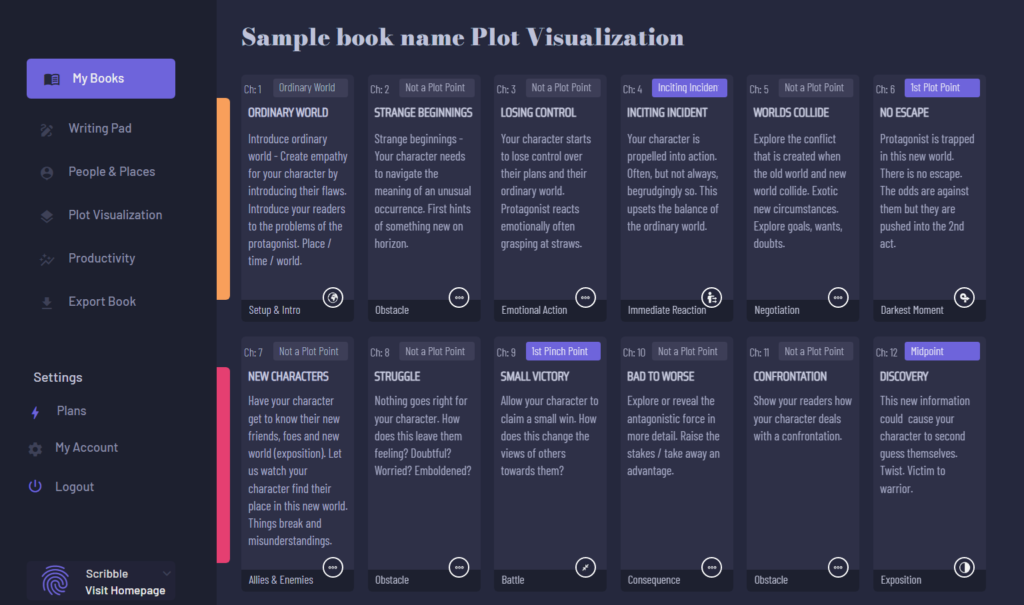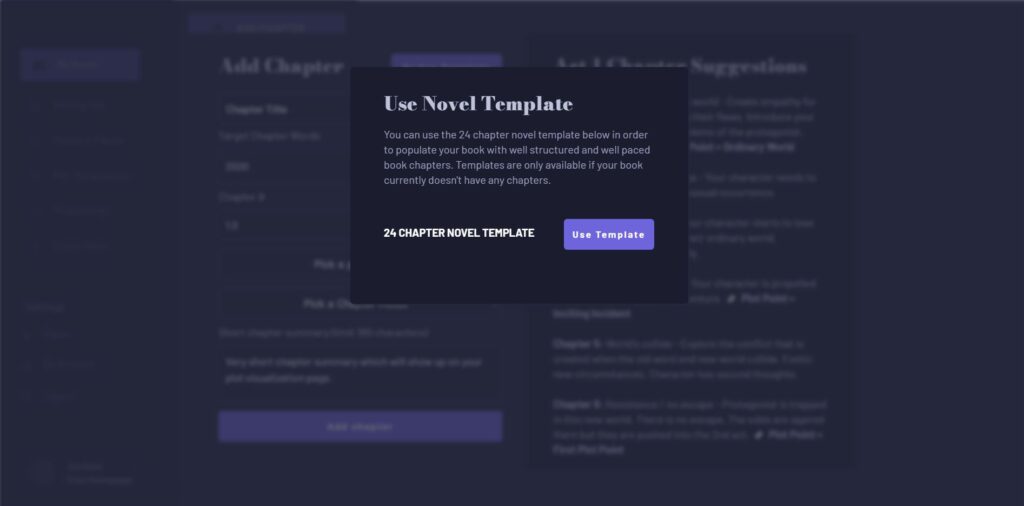SCRIBBLE.SO
Book Outline For “Artsy” Authors (With Examples)
In this tutorial we’ll look at how to write book outlines and their importance even for the more artistically inclined.
![]() Software version 1.8.0
Software version 1.8.0

Are You Too Creative and Imaginative for Book Outlines?
In this tutorial I want to teach you how to write book outlines quickly. However, more than that, by the time you finish this tutorial, I want you to see book outlines as a creatively liberating force, not a restrictive force.
Does Story Structure Hold You Back Creatively?
Today, I want to teach you that story structure does not hold you back creatively. I want to do this, because here when I’m in Scribble, you’ll see I have this option to create a novel based on a plot template. And when I do this and jump over to my plot visualization page, here I have a 24 page book, with the acts all laid out, and the plot points in place and little summaries of each chapter.

Now what I want to do today is dispel the assumption, that when you use a story structure template like this, that it will result in all stories being carbon copies of each other.
That’s absolutely not the case at all, and I’m going to show you, using an example of a short story called “The Overcoat” written by Nikolai Gogol.
Gogol is a Ukrainian born Russian, who is considered sort of a writer’s writer. He’s someone who’s influenced some of literature’s greatest, including Kafka and Doestevfky.
Nabakov even declared that the book we’re going to explore in today’s tutorial is:
“The greatest Russian short story ever written”
I’m using him as an example because he’s regarded as someone who is imaginative and unique. He even incorporates a lot of surrealist elements into his work making some inclined to believe that he might be more prone to push back against traditional narrative norms and structures.
And the thing I’m going to show you, that I hope at least shocks you to some degree, is that this book, as creative as it is and as respected as it is in artistic communities, is still quite rigid when it comes to story structure. In fact, what I’m going to show you, is that this book uses entire parts of this template.
Now, keep in mind that we’re not going to look at every section of this book and every plot point, but we are going to look at the first act which you can see represented by orange in the screenshot above.
If you want to set this up yourself, remember, just head over to scribble (create an account if you need to), create a new book, then when prompted to add chapters, just click on the button which allows you to use a template instead. After that, you’ll have 24 templated chapters in front of you.

Book Outlining Example
Now what I hope you get from this tutorial is that it’s not so much the structure of a story so much as the contents within that structure that determine the experience for both you as the author as well as your readers.
And this gives you, as an author, a lot of room to express yourself creatively. These structural guardrails often aid you, because as your focus tightens, your creativity is heightened, because extraneous information is filtered out.
For the most part readers are looking for a sense of familiarity when it comes to form. You don’t need to wow them with your creative re-interpretation of Aristotle’s “Poetics”. You don’t need to rebelliously cut out the end of a novel just for the sake of breaking rules. And you don’t need to create a character with no character arch, just to say you created a character with no arch.
Now, don’t get me wrong, there are some amazing novels that break all sorts of rules. Borges, for example, has stories with no main characters. But if you’re just starting out, follow the advice of PIcaso when he said:
“Learn the rules like a pro, so you can break them like an artist.”
But again, I don’t think the concepts of rules and artistry are opposing forces here in any way. They are complementary and codependent in more ways than not as I’m about to show you.
I think part of this misconception arises because often when teaching story structure, authors often cite the quintessential commercial novels of our time. This isn’t necessarily a bad thing, but it really narrows your thinking as an author.
When you hear the phrase “inciting incident” you think of Harry Potter when he receives his invitation to Hogwarts School. Or you think of the Hobbit where Bilbo Baggins gets a knock on the door from a wizard and his whole world gets flipped upside down.
Don’t get me wrong, these are good stories, but when used over and over as structure examples, they create stock ideas and images in our minds that narrow our thinking. So my argument today is that you need to fight against these stock images because these images, not the structure itself, is responsible for narrowing your imagination.
As an example, as I mentioned, I want to talk about Nikolai Gogol’s critically acclaimed short story “The Overcoat”.
It’s a short story, and it’s in the public domain so if you want to read it or listen to an audio version of it you can, but it’s not necessary. I set this up so you can follow along without having read the short book.
So essentially, and spoilers alert, the story is about a low level official who really has nothing going for him. He has no interests outside of the copying he does at work, he’s mostly rejected by his workmates and he has absolutely no sense of style. But his entire world changes, when his old coat, which is so worn by the forces of time, is damaged beyond repair and our protagonist is forced to buy a new overcoat. And when he gets this new coat, his entire world changes and people start treating him differently. He’s invited to parties, and he drinks champagne and well… His heart, for maybe the first time in his life, starts to beat.
Let’s jump in.
Book Outline: Plot point 1
So let’s look at our scribble plot template. Here we can see what chapter one suggests we write about. It says:
Introduce ordinary world – Create empathy for your character by introducing their flaws. Introduce your readers to the problems of the protagonist. Place / time / world.
So surely someone like Gogol wouldn’t start in such an obvious place right? WRONG.
So our story starts off below with the introduction of the protagonist Akakii Akakievich.
“So, in a certain department serves a certain official—not a very prominent official, it must be allowed—short of stature, somewhat pockmarked, rather red-haired, rather blind”
Next, we learn about the protagonist’s occupation.
“When and how he entered the department, and who appointed him, no one could remember. However much the directors and chiefs of all kinds were changed, he was always to be seen in the same place, the same attitude, the same occupation—the same official for letters; so that afterwards it was affirmed that he had been born in undress uniform with a bald spot on his head.”
The book continues.
“No respect was shown him in the department. The janitor not only did not rise from his seat when he passed, but never even glanced at him, as if only a fly had flown through the reception-room.”
This first narrative “container” continues by exploring in more detail how his coworkers ridicule and bully him. To overcome these hardships, we learn about his singular focus on his occupation as a copier.
“It would be difficult to find another man who lived so entirely for his duties. It is saying but little to say that he served with zeal: no, he served with love. In that copying, he saw a varied and agreeable world.”
Book Outline: Plot Point 2
Okay, so now we’ve setup this world. It’s pretty bleak, but now, according to our Scribble template (above), we need to start breaking this world. our 2nd chapter template says:
“Strange beginnings – Your character needs to navigate the meaning of an unusual occurrence. First hints of something new on the horizon.”
So how does this fit into the overcoat? On his walk home from work, Akakii notices the bitter cold getting through his cloak, which made him uncomfortable. The book states that after work when examining his overcoat at home, he:
“discovered that in two places, namely, on the back and shoulders, it had become thin as mosquito-netting: the cloth was worn to such a degree that he could see through it, and the lining had fallen into pieces.”
And then we learn a little bit more about his old coat.
“You must know that Akakii Akakievich’s overcoat served as an object of ridicule to the officials: they even deprived it of the noble name of overcoat, and called it a kapota.”
At this point, the protagonist brings his coat to Petrovich, the tailor, to repair.
“ascending the stairs, Akakii Akakievich pondered how much Petrovich (the tailor) would ask, and mentally resolved not to give more than two rubles.”
So here we see the protagonist is set on repairing, NOT replacing his old cloak.
But problems arise when the tailor, Petrovich, spreads the coat out in his hands and says:
“No, it is impossible to mend it: it’s a miserable garment!”
Now the protagonist pleads with the tailor. But to no avail. And the tailor finally commands:
“But it is plain that you must have a NEW overcoat. ”
Book Outline: Plot point 3
So now we’re in a place where the protagonist is losing control of their ordinary world.
Plot point three states that:
“Your character starts to lose control over their plans and their ordinary world. Protagonist reacts emotionally, often grasping at straws.”
The book continues:
“At the word new, all grew dark before Akakii Akakievich’s eyes, and everything in the room began to whirl round.”
The protagonist asks how much a new coat will cost
“Well, you would have to lay out a hundred and fifty or more,” said Petrovich”
“A hundred and fifty rubles for an overcoat!” shrieked poor Akakii Akakievich—shrieked perhaps for the first time in his life”
“Yes, sir,” said Petrovich, “for any sort of an overcoat. If you have marten fur on the collar, or a silk-lined hood, it will mount up to two hundred. ”
Now, in this section, just before the inciting incident, you often hear about the “refusal to the call”. The protagonist is being pulled in a direction, but they push back against this looming change. They don’t want to cross this threshold into uncharted territory. And the same is true here in the “overcoat”.
The protagonist schemes a plan to revisit the tailor when the tailer is expected to be drunk and his wife will be out. Thereore, the tailor will be more likely to give him a better price or just patch his old coat. But in the end, his plan fails and the tailor refuses to patch the coat.
Book Outline: Plot Point 4
So now we’re bridging over into the inciting incident, where something happens that will break the protagonist’s ordinary world and propel them into an exotic and strange new world.
In Scribble, our template prompts us to use the following action:
“Your character is propelled into action. Often, but not always, begrudgingly so. This upsets the balance of the ordinary world.”
So during the debate with the tailor, the protagonist realizes that he’s not going to win.
“Then Akakii Akakievich saw that it was impossible to get along without a new overcoat, and his spirit sank utterly.”
In this section, we have the inciting incident… the ordering of the new overcoat, which he can’t even afford.
Book Outline: Plot point 5
So now we’re thrown into this next plot card here which states that we need to:
“Explore the conflict that is created when the old world and new world collide. Exotic new circumstances. Explore goals, wants, doubts.”
So here, we have our protagonist considering how he’ll afford his coat. He doesn’t know where the money will come from, but he does mention that he has some savings.
“At the end of each half-year, he counted over the heap of coppers, and changed it into small silver coins. This he continued for a long time; and thus, in the course of some years, the sum proved to amount to over forty rubles.”
But this isn’t enough, so he starts to plan. He:
“thought and thought, and decided that it would be necessary to curtail his ordinary expenses, for the space of one year at least—to dispense with tea in the evening; to burn no candles.”
There is so much friction created when the old world represented by the old coat and the new world represented by the new coat collide.
Book Outline: Plot point 6
The next section of the book explores the world of the protagonist being trapped in this cross over. In our plot notes here it says:
“Protagonist is trapped in this new world. And the odds are against them.”
The book continues with the protagonist reflecting on their transition into this new world, and the sacrifices he’s making to be able to afford his new coat.. The book continues.
“To tell the truth, it was a little hard for him at first to accustom himself to these deprivations; but he got used to them at length, after a fashion, and all went smoothly—he even got used to being hungry in the evening;”
But we learn more about the character and the increasing importance of this goal when it’s stated that he made up for the pain by:
“bearing ever in mind the thought of his future coat. From that time forth, his existence seemed to become, in some way, fuller, as if he were married, as if some other man lived in him, as if he were not alone, and some charming friend had consented to go along life’s path with him—and the friend was no other than that overcoat, with thick wadding and a strong lining incapable of wearing out. He became more lively, and his character even became firmer, like that of a man who has made up his mind, and set himself a goal.”
“Fire gleamed in his eyes: occasionally, the boldest and most daring ideas flitted through his mind; why not, in fact, have marten fur on the collar? The thought of this nearly made him absent-minded.”
Now, on this plot card, the protagonist comes up with all of the money for the coat and the section ends by stating:
“His heart, generally so quiet, began to beat.”
Structure isn’t your enemy
So as you can see, we have this incredible story about something so simple, yet so powerful and dramatic unfolding. Previously, before I told you this story, if I told you a good inciting incident could be “buying a jaket” (or having the weather ruin your old jacket) you might think – “no that won’t work. How could I make that interesting?” But as you can see, with good writing and some creativity, it’s possible.
So as you can see, structure isn’t fighting against creativity here, it’s housing it. We’re hitting all of these structural benchmarks but as readers we hardly notice it. It’s invisible. It doesn’t feel templated or like it’s a copy of anything. It’s unique and creative, even though the structure is quite rigid.
So don’t rebel against this structure, especially if you’re just starting out, just learn to look at it more creatively.
Book Outlining Conclusion
So that’s all I have for you today. I hope you found this valuable.
Also, remember to sign up for Scribble writing software if you want to get access to the writing tools and the book outline template featured in this tutorial.

We Help You Keep it All in Your Head
![]() Software version 1.0.0
Software version 1.0.0

A software solution designed to help writers complete compelling stories.
 Version 1.8.0
Version 1.8.0
PRODUCT
All Features
Pricing
Productivity
Story Structure
World Building
Character Building
USE CASES
Novels
Essays
Memoirs
Reports
Kids Books
